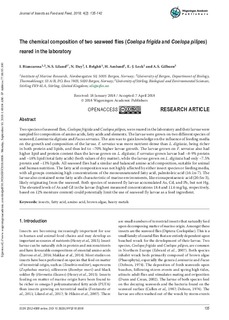| dc.description.abstract | Two species of seaweed flies, Coelopa frigida and Coelopa pilipes, were reared in the laboratory and their larvae were sampled for composition of amino acids, fatty acids and elements. The larvae were grown on two different species of seaweed, Laminaria digitata and Fucus serratus. The aim was to gain knowledge on the influence of feeding media on the growth and composition of the larvae. F. serratus was more nutrient-dense than L. digitata, being richer in both protein and lipids, and thus led to ~70% higher larvae growth. The larvae grown on F. serratus also had higher lipid and protein content than the larvae grown on L. digitata; F. serratus-grown larvae had ~8-9% protein and ~18% lipid (total fatty acids) (both values of dry matter), while the larvae grown on L. digitata had only ~7.5% protein and ~13% lipids. All seaweed flies had a similar and balanced amino acid composition, suitable for animal and human nutrition. The fatty acid composition was not highly affected by either insect species or feeding media, with all groups containing high concentrations of the monounsaturated fatty acid, palmitoleic acid (16:1n-7). The larvae also contained some fatty acids characteristic of marine environments, like eicosapentaenoic acid (20:5n-3), likely originating from the seaweed. Both species of seaweed fly larvae accumulated As, Cd, and Pb, but not Hg. The elevated levels of As and Cd in the larvae (highest measured concentrations 18.4 and 11.6 mg/kg, respectively, based on 12% moisture content) could potentially limit the use of seaweed fly larvae as a feed ingredient. | nb_NO |
